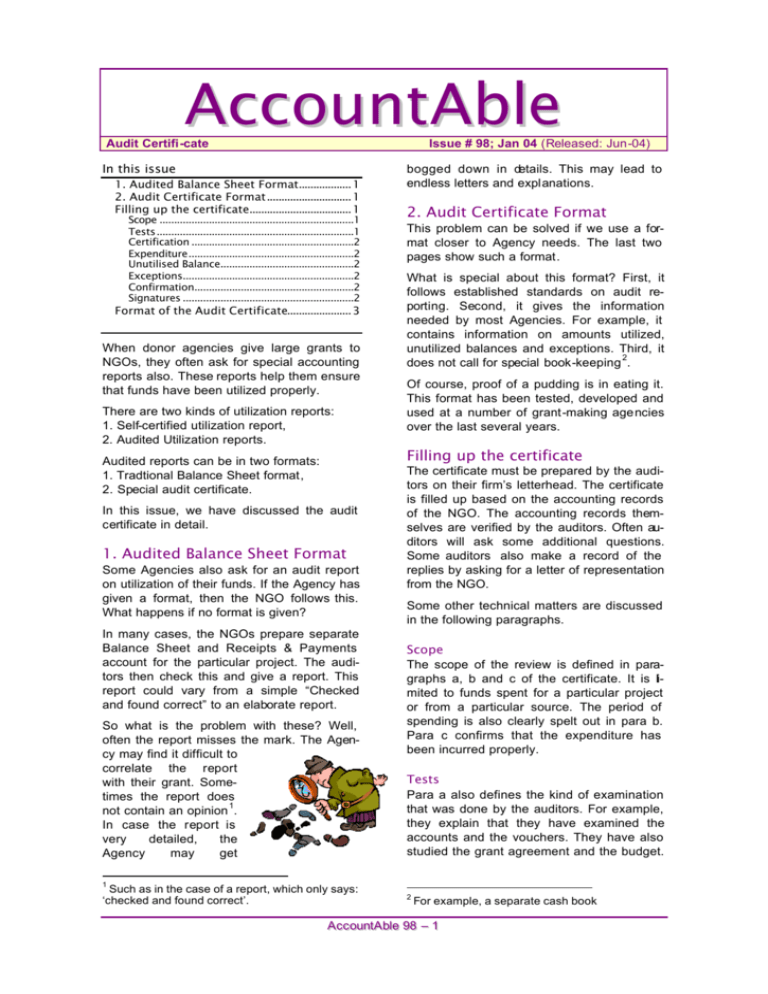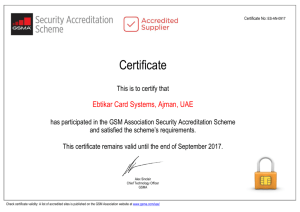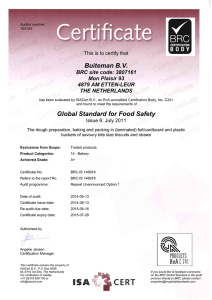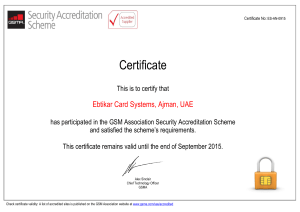Audit Certificate - AccountAid India
advertisement

AccountAble
Audit Certifi-cate
Issue # 98; Jan 04 (Released: Jun-04)
In this issue
1. Audited Balance Sheet Format.................. 1
2. Audit Certificate Format ............................. 1
Filling up the certificate................................... 1
Scope ...................................................................1
Tests ....................................................................1
Certification ........................................................2
Expenditure.........................................................2
Unutilised Balance..............................................2
Exceptions...........................................................2
Confirmation.......................................................2
Signatures ...........................................................2
Format of the Audit Certificate...................... 3
When donor agencies give large grants to
NGOs, they often ask for special accounting
reports also. These reports help them ensure
that funds have been utilized properly.
There are two kinds of utilization reports:
1. Self-certified utilization report,
2. Audited Utilization reports.
bogged down in details. This may lead to
endless letters and explanations.
2. Audit Certificate Format
This problem can be solved if we use a format closer to Agency needs. The last two
pages show such a format.
What is special about this format? First, it
follows established standards on audit reporting. Second, it gives the information
needed by most Agencies. For example, it
contains information on amounts utilized,
unutilized balances and exceptions. Third, it
2
does not call for special book-keeping .
Of course, proof of a pudding is in eating it.
This format has been tested, developed and
used at a number of grant-making agencies
over the last several years.
Filling up the certificate
Audited reports can be in two formats:
1. Tradtional Balance Sheet format,
2. Special audit certificate.
In this issue, we have discussed the audit
certificate in detail.
1. Audited Balance Sheet Format
Some Agencies also ask for an audit report
on utilization of their funds. If the Agency has
given a format, then the NGO follows this.
What happens if no format is given?
In many cases, the NGOs prepare separate
Balance Sheet and Receipts & Payments
account for the particular project. The auditors then check this and give a report. This
report could vary from a simple “Checked
and found correct” to an elaborate report.
So what is the problem with these? Well,
often the report misses the mark. The Agency may find it difficult to
correlate the report
with their grant. Sometimes the report does
1
not contain an opinion .
In case the report is
very
detailed,
the
Agency
may
get
The certificate must be prepared by the auditors on their firm’s letterhead. The certificate
is filled up based on the accounting records
of the NGO. The accounting records themselves are verified by the auditors. Often auditors will ask some additional questions.
Some auditors also make a record of the
replies by asking for a letter of representation
from the NGO.
Some other technical matters are discussed
in the following paragraphs.
Scope
The scope of the review is defined in paragraphs a, b and c of the certificate. It is limited to funds spent for a particular project
or from a particular source. The period of
spending is also clearly spelt out in para b.
Para c confirms that the expenditure has
been incurred properly.
Tests
Para a also defines the kind of examination
that was done by the auditors. For example,
they explain that they have examined the
accounts and the vouchers. They have also
studied the grant agreement and the budget.
1
Such as in the case of a report, which only says:
‘checked and found correct’.
2
For example, a separate cash book
Ac c ountAble 98 – 1
Later, in para e, they make other important
statements regarding the audit tests.
quality of the audit. They also tell the reader
whether the NGO is following the terms of
the agreement or not.
Certification
Three issues are certified by this document:
Signatures
Along with the signatures, additional contact
information is also provided. The auditors
should put their seal on all the pages. They
should also sign all the pages for additional
authenticity.
1.
Amount of expenditure incurred under the project (para b);
2.
Nature of expenditure and its conformity with the budget (para c);
3.
Compliance with donor agency requirements (para d.4).
Expenditure
Table A provides a summary of the expenditure incurred for the project. This table
should only show expenditure out of the donor Agency’s funds. Expenditure from own
funds or from community contribution etc.
should not be included here.
The suggested format is for a multi-year
project. If your donor gives single-year
grants, then some of the columns can be
deleted. The columns may then look as
shown here:
Budget
line item
Amount
budgeted
Amount
spent
Variance
Unutilised Balance
Table B provides a cash flow summary for
the reporting period. At the bottom of the table is shown the unutilized balance at the
end of the period. Would this be different
from the cash balance of the grant?
In many cases, the answer would be yes. In
actual practice, some of the unutilized balance may be with staff as program advance,
some may be in bank on current or term deposit, and rest may be in form of cash.
The cash balance that most agency-wise
Receipts & Payments Account, is mostly a
theoretical figure only.
Exceptions
The auditors may have some doubts about a
particular expense item. It may be that the
auditors are not satisfied about the quality of
supporting documents. Or they may be unsure that the item should be booked under
this project. They can tabulate such cases in
para c.
If possible, the certificate can be printed back
to back. This saves stationery and reduces
the risk of mix-up of pages from different
years.
What is AccountAble: 'AccountAble' covers a
different topic related to NGO regulation or accounting each month and is mailed to about 1,700
persons in NGOs, Agencies and audit firms. AccountAid encourages reproduction or redistribution of ‘AccountAble’ in workshops or NGO
newsletters for non-commercial use, provided the
source is acknowledged.
AccountAble in Hindi: Aka%{qebl ihNdI me< ‘leoayaeg' ke nam se %plBx hE,
Interpretation of law: Interpretation of law given
here is of a general nature. Please consult your
advisors before taking any important decision.
AccountAble on the Web: All the past issues of
‘AccountAble’ are available on our web-site
www.accountaid.net.
AccountAid Capsules: Short items of information on NGO accounting and related issues. To
subscribe,
send
e-mail
to
accountaidsubscribe@topica.com .
Questions?: Your questions, comments and
suggestions can be sent to AccountAid India, 55B, Pocket C, Siddharth Extension, New Delhi-110
014; Phone: 011-2634 3128; Ph./Fax: 011-2634
6041; e-mail: accountaid@vsnl.com ; accountaid@gmail.com .
© AccountAid™ India ra:q+Iy zk 1926 Jyeó , June
2004 CE;.
Published by AccountAid India, New Delhi;
Printed at Chanakya Mudrak Pvt. Ltd., New Delhi.
Ph.: 5142 0316, 2592 3951
For private circulation only.
Confirmation
Para d provides several important confirmations. These reassure the reader as to the
Ac c ountAble 98 – 2
Format of the Audit Certificate
To,
(Name and location of the Donor Agency)
a. We,
(name of the audit firm)
, the Auditors of (name of Society / Trust)
have examined the books of Account and other records, including vouchers and supporting documents,
of
(name of Society / Trust)
. We have also carefully examined the agreement / letter containing terms & conditions for support, dated
(date of the letter)
, signed between
(name of donor agency)
and
(name of Society / Trust)
for the grant of
funds covered by this certificate and the budget approved by the donor agency. We have also
obtained such explanations and clarifications from the Secretary/ Chief Functionary as we considered necessary for the purpose of this certificate.
b. On the basis of the above examination, we certify that
incurred the following expenditure during the period from
(name of Society / Trust)
(date)
till
(date)
has
.
Title of the Project: __________________________________
A: Expenditure (All amounts in Indian Rupees)
Budget Line Item
3
Total For this reporting period
Cumulative
SancBudget Actual VariBudget Actual
tioned
Spent
ance
Spent
Budget
Grand Total
B. Unutilised Balance of Funds (amounts in Rupees)
1. Agreement and Disbursal
Total amount sanctioned so far by
Total amount disbursed so far
3
Please add more lines if required.
(name of donor agency)
2. Unutilised balance
Opening balance of unutilised funds
Add: Total grant received during this period
Total funds available
Less: Amount spent during this period (Grand Total of Table A)
Closing balance of grant Funds
c. We also certify that the above expenditure has been truly and properly incurred in accordance
4
with the Budget and agreement referred to above, except for the following items :
Item
Amount (Rs.)
Comments
d. We further confirm the following:
1.
We have carried out the above examination according to Standard Auditing Practices.
2.
We are adequately satisfied about the reliability, authenticity and genuineness of the records
and supporting documents produced before us.
3.
(name of Society / Trust)
has maintained the books of account properly, in accordance
with the law and Generally Accepted Accounting Principles.
4.
(name of Society / Trust)
has complied with all the essential accounting requirements laid
down in the agreement / letter referred to in para ‘a’, except for the following:
q
q
q
.
5.
To the best of our knowledge and belief, and according to the examination of accounts carried out by us,
(name of Society / Trust)
has not received / has received other
funds for purposes similar to the above grant.
Yours faithfully
for
name of CA Firm
Chartered Accountants
(
Name of CA
) Membership No.
Date:
Phone:
Partner / Proprietor
Note: Auditors should put their seal on all pages. They should sign other pages as well.
4
Please write ‘Not applicable’ in the table if there are no such items. This requirement relates to substantive
variations, such as those related to nature of the expenditure / payment. There is no need to report overspending or under-spending here.







